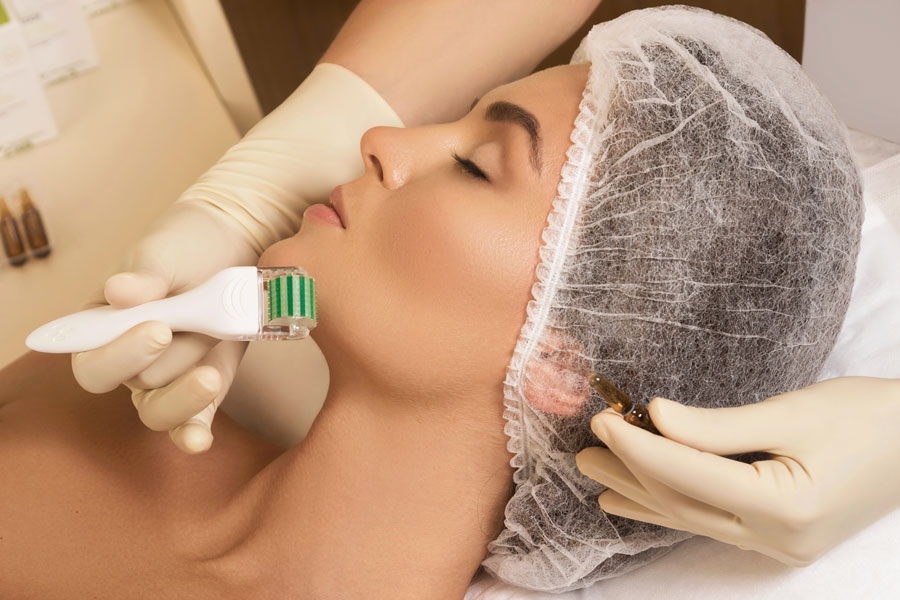10 Things About Microneedling
Written by Terri WojakMicroneedling is a treatment in which multiple needles are stamped, rolled, or glided across the skin for the purpose of skin rejuvenation. Needling was discovered by Dr. Orentriech when he used 18- to 20-gauge needles on depressed scars and deep wrinkles. Dr. Des Fernandes, one of the pioneers of microneedling, went on to develop a needling stamp to cover a larger area at once. Soon after, the needling rollers were created and microneedling took off as a great technique for overall skin rejuvenation. It wasn’t until 2010 that the automated needling devices came to the market, which are widely used today. Skin needling can be very superficial, with cosmetic rollers or stamps that go up to 0.3 millimeters, or deep, where the needles penetrate up to three millimeters into the skin.
- Microneedling creates a controlled wound response. Past treatments for skin rejuvenation included creating a wound in the skin to get a response – for example, the use of deep chemical peels and dermabrasion that left clients with six to eight weeks of downtime. Today, treatments like microneedling are aimed at creating a wound-response, not necessarily a wound.
- Microneedling is commonly called collagen induction therapy. Microneedling triggers a response in the skin, stimulating fibroblasts to increase collagen production. It is this collagen production that builds the architecture of the skin, allowing for such great results.
- Cosmetic needling is used for product penetration. Microneedling with stamps or rollers at 0.3 millimeters or lower creates microchannels in the skin, allowing products to penetrate more effectively. Immediately after needling is the perfect time to apply beneficial ingredients to enter the skin.
- Many medical practices perform needling with platelet-rich plasma. Platelet-rich plasma is a portion of the blood that has growth factors, stem cells, and other nutrients that are beneficial for aging skin. When platelet-rich plasma is added, blood is drawn from the client and spun in a centrifuge to separate the platelet-rich plasma from the blood, which is then topically applied or injected back into the skin. Platelet-rich plasma is done by medical professionals only, since it does require a blood draw.
- Microneedling is FDA-approved as a class two device. The approval is for the treatment of acne scars. Although it shows great improvement for many other skin conditions, all other uses are considered off-label.
- Microneedling can be used on almost all skin types and conditions. Microneedling is most commonly used for fine lines, wrinkles, and acne and surgical scars. It is also used non-inflamed rosacea, hyperpigmentation, stretch marks, and alopecia. It is safe for use on all Fitzpatrick types, with little concern for post-inflammatory hyperpigmentation.
- Microneedling works great on stretch marks. Stretch marks are caused by tearing of the dermis. Since microneedling induces a wound response to build collagen, it helps to build the dermis, reducing the appearance of stretch marks.
- There is no down-time with microneedling. The skin typically has some mild erythema for up to three days but no significant redness. Clients can feel dry following the procedure, so extra moisture is recommended, but makeup can be worn as early as the next day.
- Results are not immediate. Although many clients seem to have a more rejuvenated appearance a few days following microneedling, it takes time to produce collagen. Collagen building typically takes two to six months, but full results can take up to a year.
- Regulations vary by state. Regulations on who can perform microneedling varies by state. Several states require the treatment to be done under medical supervision; others allow aestheticians to perform the treatments up to 0.5 millimeters. Always check with your individual state regulatory boards to ensure you are working within your scope of practice.
Microneedling is a great procedure with many benefits and little risk. It is important for aestheticians to learn about microneedling, even if it can’t be performed in their state. Clients are savvy these days and are looking to you for professional advice on skin care treatments.
 Terri Wojak is a highly sought-after professional with over 20 years of experience in the aesthetic industry. Her most recent role was president of True U Education. She now works as education director of GlycoAla and runs her own education company, Aesthetics Exposed Education. She is a respected authority on skin care in a medical setting, education, and business development on multiple levels. Wojak has built 50 individual courses based on skin care in a medical setting. More than 100 articles by Wojak have appeared in a multitude of industry magazines and she has published two books, “Aesthetics Exposed: Mastering Skin Care in a Medical Setting & Beyond,” in May 2014, and “Mastering Medical Esthetics,” debuted in 2009. Wojak has trained over 5,000 aestheticians and medical professionals on the importance of incorporating skin care into cosmetic medicine, ultimately helping clients and medical providers alike.
Terri Wojak is a highly sought-after professional with over 20 years of experience in the aesthetic industry. Her most recent role was president of True U Education. She now works as education director of GlycoAla and runs her own education company, Aesthetics Exposed Education. She is a respected authority on skin care in a medical setting, education, and business development on multiple levels. Wojak has built 50 individual courses based on skin care in a medical setting. More than 100 articles by Wojak have appeared in a multitude of industry magazines and she has published two books, “Aesthetics Exposed: Mastering Skin Care in a Medical Setting & Beyond,” in May 2014, and “Mastering Medical Esthetics,” debuted in 2009. Wojak has trained over 5,000 aestheticians and medical professionals on the importance of incorporating skin care into cosmetic medicine, ultimately helping clients and medical providers alike.
